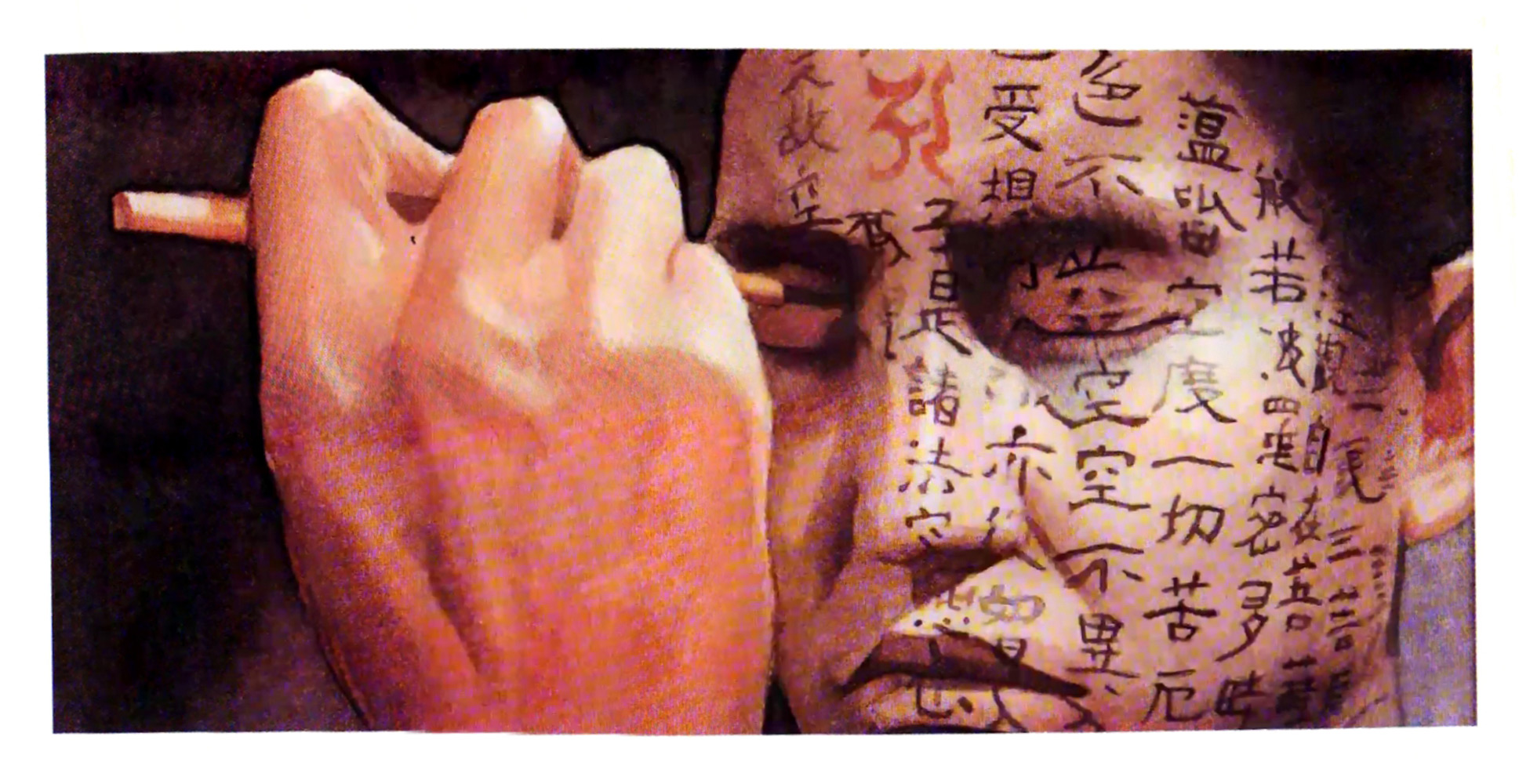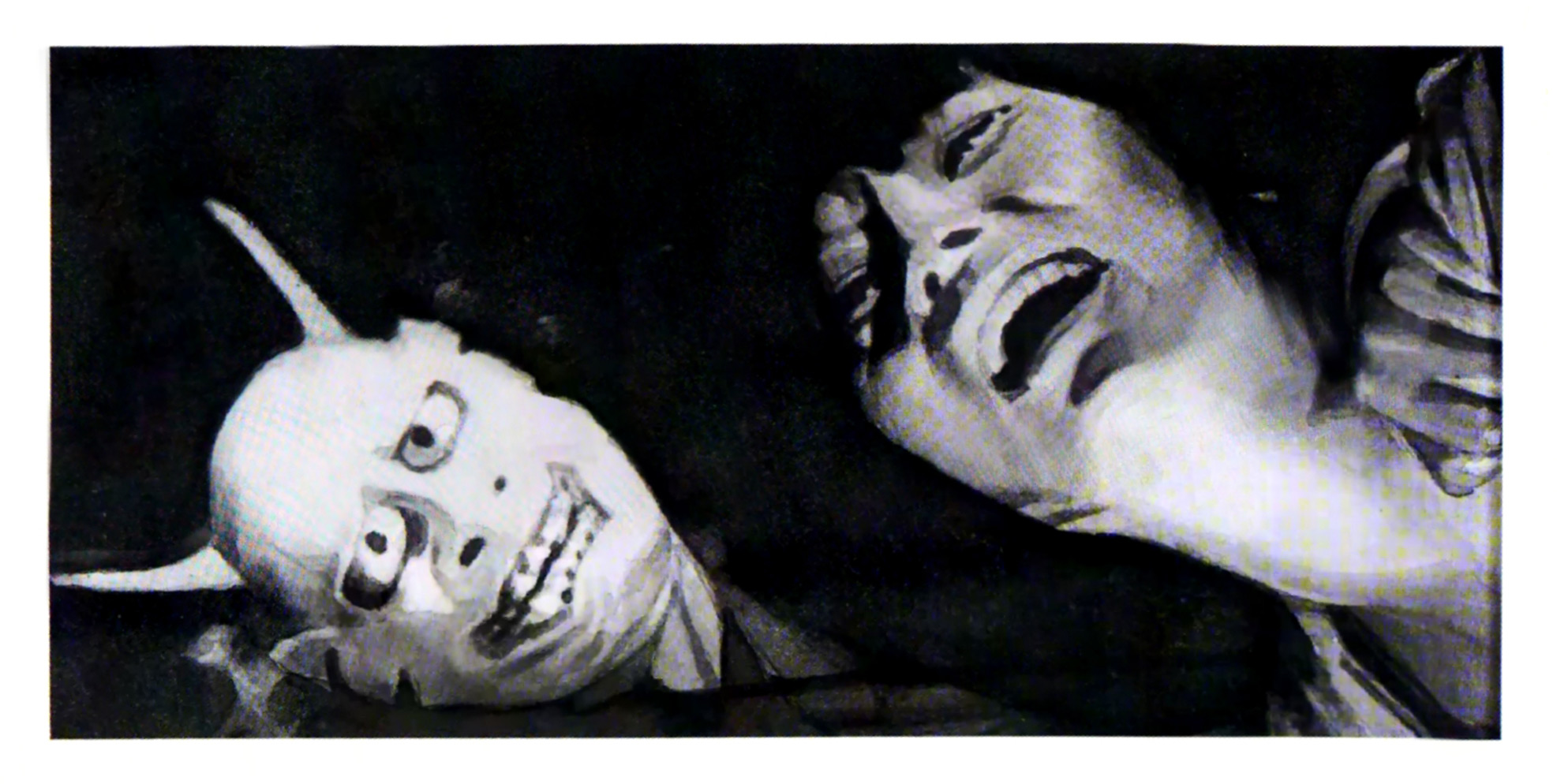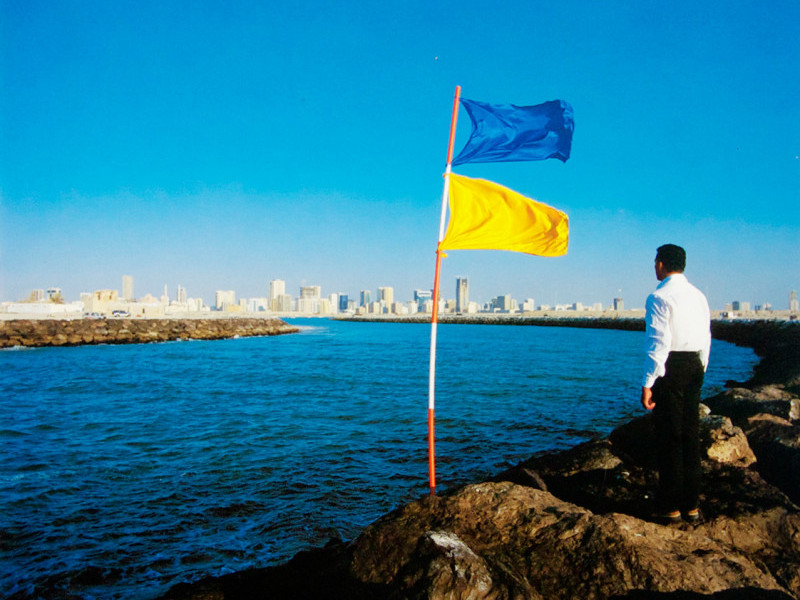
Cinema City-Kwaidan, 1964
Steven Wong
Cinema City-Kwaidan, 1964
Masaki Kobayashi, 1999-2002
Framed watercolour
search


Steven Wong
Cinema City-Kwaidan, 1964
Masaki Kobayashi, 1999-2002
Framed watercolour
"Cinema City" is made up of two distinct but intimately connected elements: a miniature architectural system/cinema complex or model cinema structure complete with working visual displays, and a series of neatly executed watercolour paintings representing key moments from highly influential Japanese films. Each of these two central features may, in turn, be further dissembled, at least conceptually, into their component parts. It is indeed within and between these complex constituents that the multiple, critical resonances of "Cinema City" can be observed and recoqnissd.
In the centre of the work resides "Cinema City" itself, comprised of a miniaturised screen cinema upon the screen is visible two individuals, each caught up in the act of engaging with a key work of Japanese cinema. Framing in shot the portraits of the participating watchers, attention is focused on the facial expressions and other physically visible responses made by these people in reaction to the film they are watching. What we as outsiders cannot see, however, but which considerably extends the critical loop of the viewing scenario is that the film's audience is viewing not only a given cIassic of Japanese cinema but, on a second screen, their own postures and poses as they consume the chosen filmic image. A live video display captures for the viewers their own response, relaying it directly to them. Thus we, as observers of "Cinema City", witness a contained double observation, see the watchers simultaneously watching both themselves and the selected film. Chosen as a foreground to a perhaps exhaustive "lexicon" of viewing responses, we witness the individual's responses to the act of watching, not only the selected film but also themselves as the arranged relay is returned to them.
As Mitsuhiro Yoshimoto and other scholars have emphasised, Japanese cinema holds a key place in the history and institutionalisation of cinematic practice and of film studies. It occupies the paradoxical territory on the one hand, of an oppositional genre, a refusal of Western (i.e. dominant) filmic conventions and on the other, provides a culturally specific filmic mode, self-contained, a unified practice with neither need nor inclination to gain its validation from, or accumulate the praises of Western critics or other members of the Western filmic institution. Furthermore, with respect to the academic discipline of film studies Japanese cinema occupies a unique place.
As Yoshimoto remarks: The success of film studies as a newly emerging discipline was inseparable from a certain spirit of contestation in the 1960's against the way knowledge was produced in the traditional humanities. The radical critics of the late 1960's and early 1970's turned to film to question the ideological underpinnings of what was considered as constituting "scholarly seriousness". The study of Japanese cinema did not remain outside this trend of theoretical radicalization. More particularly, it was Japanese cinema which constituted one of the prime objects of study within the new discipline of film studies, to the degree that without its presence this new discipline would not have materialised at all. Given this specificity of position the selection of the genre may be seen to be anything but arbitrary. Its double positioning as a force in opposition to, but also independent of Western filmic norms give it an ambiguous status. It is both within and exterior to the established frame, yet reliant upon (because it apparently opposes it) Western film, but simultaneously and intractably, other.
Adjacent to the miniaturised city the watercolours offer another "take" upon the materials described above, whilst realigning their already multiple implications and meanings. Their juxtaposition with the cinematic structure raises several Questions about representation and its repercussions in contemporary culture. The medium of watercolour may be called traditional, unadventurous, a kind of academic practice not normally aligned with novel ways of seeing. Yet it is this very conventionality that acts as a kind of distancing device, one through which we might consider the still young medium of cinema in a different light. Having picked key moments from the vast body of work that is "Japanese cinema", watercolours have been made which, if read as a potential narrative, give to the viewer a kind of shorthand model of a possible but as yet unrealised cinematic project, a cinema of cinema as it were. And, paralleling the double-edged presence of Japanese film, the ambiguity of watercolour as a "high culture" yet "amateur" art form echoes what is both most problematic and productive about cinema from Japan. Watercolour painting is a sophisticated, difficult medium to master but it is also the first and most obvious choice for would-be artists, a relatively cheap and accessible field of effects. Its necessary tools, the brushes and paints and papers, are easy to obtain and transport, its apparently fantastic effects at least in principle open to all.
To place work in watercolour - the very model of a tradition recognised by all but mastered, in actuality by only the few - next to a miniature cinema complex employing state-of-the-art digital technology is a thought provoking move. Is film, especially when transferred to the even more modern medium of video, a new version of watercolour painting for contemporary culture? Have the technologies of film and video rendered watercolour painting, with its cumbersome conventionalities of the hand-made layering of colour and line irrelevant, a merely nostalgic method of representation? Or is it that the new media can't compete with - or at least not entirely overthrow _ the accumulated strength and historical power of the hand-painted image? Perhaps it is even possible to claim that the aesthetics of cinema still somehow cling to those long established within painting, forever doomed to repeat these forms of looking and of thinking about how we might represent the world we occupy. The decision to repeat in watercolour only those film instants already photographically frozen, reproduced via the camera and printed in books and magazines, itself encourages further pause for thought. The "disordered ordering" of the relationship between film still and its painted representation disrupt any potentially "neat" reading of the mediums under discussion, throwing standard ideas of chronologically-determined influence into doubt.
Taken as a whole, the multiple parts of "Cinema City" act as a spectacular mesh of mirrors, the piece being a compositionally ordered construction in which notions of fixity, direction and directness of viewing are deconstructed, "deranged" and then reassembled; in fact this process is an ongoing one within the work, as though the piece is a restless machine committed to the making and remaking of meaning.
The cinema cannot be separated from the industrial urban environment in which it developed. It is truly integrated within the contingencies of Modernist culture, and whether it can survive intact within the present or future analytical climate remains to be seen. In this respect, "Cinema City" may be in part an archive of the problems of history. Forcing the viewer to look into the very nature of the cinematic gaze and its attendant cultural representations, "Cinema City" is, finally, an "irreducible" work: an examination of cinema and its multiple subjects. An archive, a clashing of visual codes, technologies and cultures, an analysis of art, power and representation.
Notes
1. It is a truism to observe that Japan is a highly traditional culture which, since World War 2, has undergone rapid and intense modernization. Thus, the contrast between traditional and modern forms of representation brought out in "Cinema City" is not without historical relevance. Miniaturisation is also a culturally loaded issue. See, for example O-Young Lee, The Compact Culture: The Japanese Tradition of "Smaller is Better", Kodansha, 1994.
2. Wong's project utilises a portable digital video-disc player whose small screens become the cinema screen within the realised piece. The individual video sequences are fifteen minutes long. At the conclusion of the sequence a well-known Japanese song, the lyrics of which refer to the winding down of a clock that is the conclusion, death, or end of an era, can be clearly heard.A watercolour relates directly to the film being watched by the recorded participants. They might be read as forming the landscape in which the city is located.
3. For a survey of Western critical reactions to Japanese Cinema see Yoshimoto's Kurosawa: Film Studies and Japanese Cinema, Duke University Press, 2000, especially pp. 7-49.
4. Yoshimoto, op. cit., p.19.
"Cinema City: excerpt 2," exhibited at Sharjah International Art Biennial is a fragment of the larger project "Cinema City." Peter SuchinlSteven Wong
"Cinema City: excerpt 2"
It is an unfamiliarity with Japanese history and culture that prevents the many from fully appreciating the value of its cinema. Steven Wong's approach, as both archivist and artist is to annotate by excerpts from specific cinematic sources, images that significantly engage our attention as art. Wong's view that Japanese cinema has become an 'object of knowledge' is also a questioning of the power of film studies as the only legitimizing protocol and authorization of meaning and significance.
Steven Wong is an artist working critically with culture. He was educated in Singapore and Los Angeles and currently lives and works in Singapore. Wong had at UCLA represented the notoriously complex and materialist films of Straub/Huillet, presenting the first 15 works as a discrete aspect of the object knowledge 'cinema'. The performance over four days aligned Wong's preoccupations toward an immersive art practice, an awareness of complex historical and social forces.
"Cinema City" is the title for an undertaking which sources the film still as an object predicated upon cinematic narratives. The series interrogates what has been (unintentionally) obscured in popular culture, or overlooked in Japan itself. 'Japanese cinema' is in the west ostensibly an aspect of 'art house', i.e. cinema culture. What therefore distinguishes these as works of art in the highly fluid mass culture industry that has branded and coded Japanese cinema to ideological purposes?
The artist presents framed watercolours as excerpts from an indefinite series, made characteristically over a set period of time. These select images, made at a measured pace at different times between Hong Kong/London/Singapore are indexical handmade signs extracted from their factual presence as unoriginal mechanical reproductions and as metonyms for cinematic narrative.
Wong's cryptic message is that cinema is open to absorption to arbitrary meaning: de-mapped and re-mapped, the majority of the films themselves remain unscreened, overlooked. They have been benignly absorbed into the art house and academic discourse of the dominant/other.
PL
Steven Wong
2003
Kaneto Shindo, 1999-2002
Framed watercolour


Sharjah Biennial 6